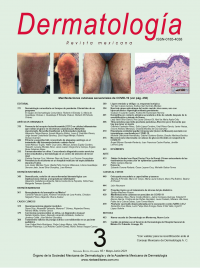Regressive giant keratoacanthoma.
Dermatol Rev Mex. 2021; 65 (3): 374-378. https://doi.org/10.24245/dermatolrevmex.v65i3.5776
Diana Díaz,1 Alexander Velandia,1 Mariana T Gómez,1 Alejandra Rivera,1 Adriana Motta,2 Andrés García1
1 Residente de Dermatología.
2 Dermatólogo, Hospital Simón Bolívar.
Universidad El Bosque, Bogotá, Colombia.
Resumen
ANTECEDENTES: El queratoacantoma se distingue por su rápido crecimiento y alivio espontáneo.
CASO CLÍNICO: Paciente masculino de 74 años con dos lesiones compatibles con queratoacantomas diagnosticados por clínica e histopatología. Uno afectaba el antebrazo derecho y otro el dorso de la mano izquierda. Ambas lesiones eran asintomáticas. Se realizó biopsia y seguimiento de las lesiones, con toma de registro fotográfico, que evidenció la involución espontánea de la lesión en el antebrazo derecho (gigante) y el dorso de la mano izquierda, pero a esta última se decidió realizar resección quirúrgica.
CONCLUSIONES: Por lo general, todos los queratoacantomas pueden tener alivio espontáneo en un periodo que varía entre 4 y 6 meses desde el comienzo de la lesión, por lo que la vigilancia clínica puede ser una opción en estos pacientes.
PALABRAS CLAVE: Queratoacantoma; neoplasia.
Abstract
BACKGROUND: Keratoacanthoma is characterize by its rapid growing and spontaneous resolution.
CLINICAL CASE: A 74-year-old male patient with two lesions compatible with keratoacanthoma, both for clinical and histopathological diagnoses. One was at right forearm with progressive growth, not painful, and the other was on the back of the left hand. Biopsy and follow-up of the lesions were carried out, in the right forearm and back of the left hand, both compatible with regressive keratoacanthomas, the giant lesions were followed up, and the second was surgically resected.
CONCLUSIONS: All keratoacanthomas can have spontenous relieve, which varies between 4 and 6 months from the beginning of the injury, so clinical surveillance may be an option in these patient.
KEYWORDS: Keratoacanthoma; Neoplasm.
Recibido: abril 2020
Aceptado: enero 2021
Este artículo debe citarse como: Díaz D, Velandia A, Gómez MT, Rivera A, et al. Queratoacantoma gigante involutivo. Dermatol Rev Mex 2021; 65 (3): 374-378.

